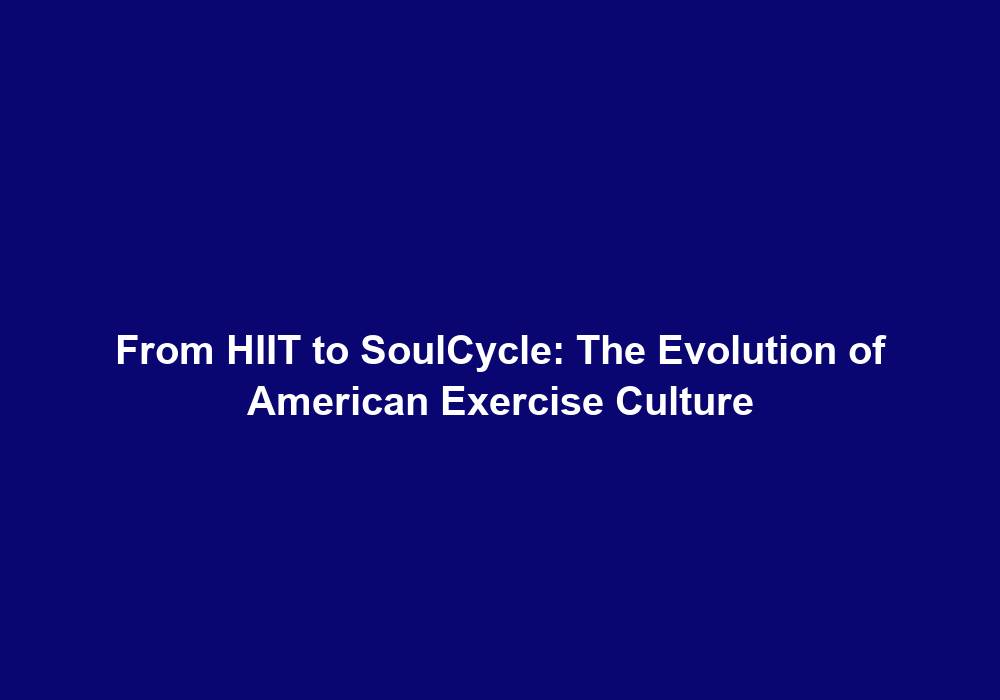From HIIT to SoulCycle: The Evolution of American Exercise Culture
Exercise culture in America has seen a remarkable evolution over the years. From traditional gym workouts to trendy fitness classes, the options for staying fit and active have diversified greatly. This article will explore the journey of American exercise culture, highlighting notable trends and the impact they have had on the health and fitness industry.
Traditional Gym Workouts
In the early days, traditional gym workouts were the primary means of exercise for Americans. People would visit local gyms equipped with basic weight machines and cardiovascular equipment like treadmills and stationary bikes. These gyms mainly catered to bodybuilders and athletes, focusing on strength training and muscle building.
With the rise of traditional gym workouts, there was a greater emphasis on individual fitness goals and body transformation. Gyms became spaces where people could push themselves to new limits and achieve the physique they desired. Weight machines allowed users to target specific muscle groups, while cardiovascular equipment provided the opportunity for endurance training. This combination of strength and cardiovascular exercises formed the foundation of traditional gym workouts.
The Rise of Aerobics and Jane Fonda
In the 1980s, aerobics gained popularity, thanks in part to the influential fitness icon, Jane Fonda. Her workout videos became a sensation, encouraging individuals to exercise in the comfort of their own homes. Aerobics classes, characterized by energetic movements and rhythmic music, soon became a staple in gyms across the country. This fitness craze motivated people to get moving and embrace a more active lifestyle.
Aerobics classes offered a fun and engaging way to improve cardiovascular fitness. The combination of dance-inspired movements and upbeat music made workouts enjoyable and accessible to people of all ages and fitness levels. The popularity of Jane Fonda’s videos played a significant role in making aerobics mainstream and encouraging individuals to prioritize their health.
The Emergence of High-Intensity Interval Training (HIIT)
As the 21st century approached, a new trend emerged in American exercise culture: High-Intensity Interval Training (HIIT). HIIT workouts involve short bursts of intense exercise followed by brief recovery periods. This form of training became popular due to its time-efficient nature and ability to provide excellent results in terms of cardiovascular fitness and fat burning.
The appeal of HIIT lies in its efficiency and effectiveness. With busy schedules becoming the norm, people were looking for workouts that could deliver maximum results in minimal time. HIIT workouts can be adapted to various exercises, including running, cycling, and strength training. The flexibility and effectiveness of HIIT attracted a diverse range of individuals, from busy professionals to fitness enthusiasts seeking a new challenge. This trend marked a shift towards more intense and time-conscious workouts.
Some benefits of HIIT include:
- Increased calorie burn: The intense nature of HIIT workouts leads to a higher calorie burn during and after the exercise session.
- Improved cardiovascular fitness: HIIT improves heart health by elevating heart rate during intervals and promoting recovery during rest periods.
- Time efficiency: HIIT workouts typically last for 20-30 minutes, making them an ideal choice for individuals with limited time for exercise.
- Fat burning: HIIT has been shown to be effective in reducing body fat percentage and increasing lean muscle mass.
Boutique Fitness Studios
In recent years, boutique fitness studios have gained significant traction within American exercise culture. These specialized studios focus on offering unique workout experiences, often centered around specific exercise styles or methods.
One notable example is SoulCycle, a company that revolutionized indoor cycling classes. SoulCycle classes combine cycling with motivational coaching and high-energy music, creating an immersive and inspiring environment. This innovative approach not only provides a challenging workout but also fosters a sense of community and camaraderie among participants.
Apart from SoulCycle, other boutique studios have emerged, each offering a distinct fitness experience. From barre classes that blend ballet-inspired movements with strength training, to hot yoga studios that incorporate yoga poses in heated rooms, these studios cater to diverse preferences and interests.
Boutique fitness studios offer several advantages over traditional gyms, including:
- Specialized workouts: Boutique studios focus on specific exercise styles or methods, allowing individuals to explore and excel in their preferred form of exercise.
- Motivational environment: The unique atmosphere and community spirit in boutique studios create a motivating environment that keeps individuals engaged and committed to their fitness journey.
- Expert instruction: Boutique studios often employ highly trained instructors who provide personalized guidance and ensure proper form and technique.
- Variety and novelty: Boutique studios continuously introduce new classes and variations, keeping workouts fresh and exciting.
The Influence of Technology
Technology has played a significant role in shaping American exercise culture. The rise of smartphones and fitness apps has made it easier than ever for individuals to track and monitor their workouts. Various fitness apps allow users to set goals, record their progress, and access workout routines designed by professionals.
Wearable fitness trackers, such as smartwatches and fitness bands, have also become immensely popular. These devices provide real-time data on heart rate, steps taken, and calories burned, helping individuals stay motivated and accountable.
Moreover, the advent of online fitness platforms has expanded access to exercise resources. From live-streamed classes to on-demand workout videos, people can now engage in guided workouts from the comfort of their homes. This increased convenience has further contributed to the diversification of American exercise culture.
Some ways technology has enhanced exercise culture include:
- Goal setting and tracking: Fitness apps allow individuals to set specific goals, track their progress, and receive personalized recommendations for improvement.
- Access to professional guidance: Online platforms provide access to expert-led workouts and training programs, eliminating the need for expensive personal trainers.
- Community support: Social features in fitness apps and online platforms enable individuals to connect with like-minded individuals, share achievements, and seek support on their fitness journey.
- Data-driven workouts: Wearable fitness trackers provide real-time feedback on heart rate, calories burned, and other metrics, allowing individuals to optimize their workouts for maximum effectiveness.
Conclusion
American exercise culture has come a long way, evolving from traditional gym workouts to a vast array of fitness options. From the aerobics craze of the 1980s to the rise of boutique fitness studios like SoulCycle, trends have shaped the way Americans stay active.
Furthermore, the integration of technology into exercise routines has revolutionized the accessibility and convenience of workouts. With the continuous evolution of exercise culture, it is clear that Americans are embracing innovative ways to prioritize their health and well-being. Exciting times lie ahead as new trends and technological advancements continue to reshape the American exercise landscape.







